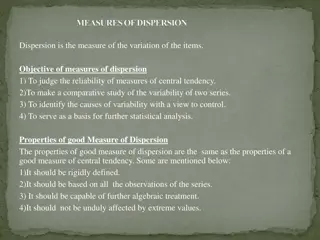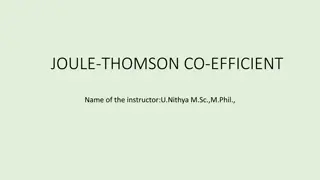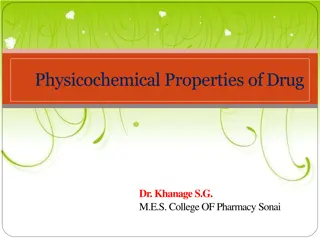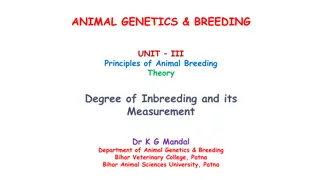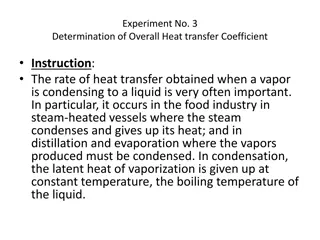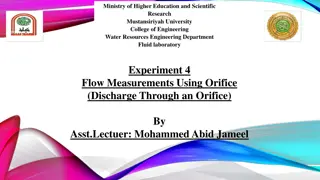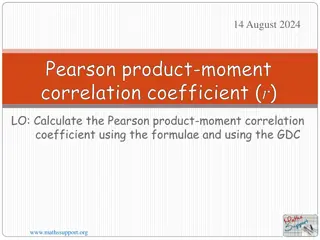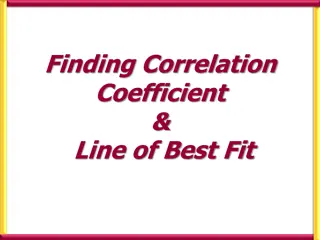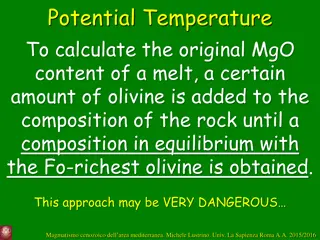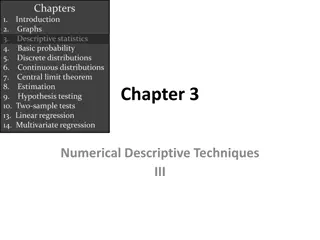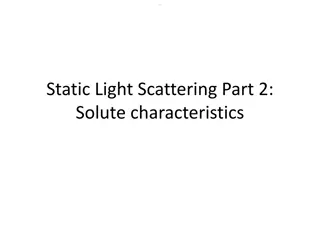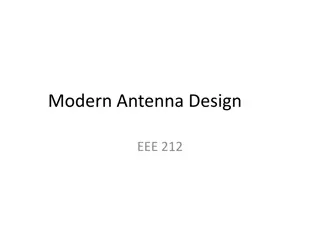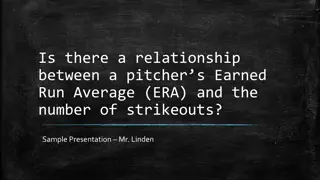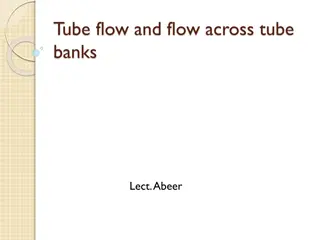Multicollinearity in Regression Analysis
Multicollinearity in regression occurs when independent variables have strong correlations, impacting coefficient estimation. Perfect multicollinearity leads to regression model issues, while imperfect multicollinearity affects coefficient estimation. Detection methods and consequences, such as incr
5 views • 11 slides
Degree of Inbreeding in Animal Genetics and Breeding
Degree of inbreeding refers to the extent to which an individual carries genes identical by descent. This concept is crucial in animal breeding as it affects genetic diversity and homozygosity in offspring. The coefficient of inbreeding is used to measure the level of inbreeding, with higher values
4 views • 30 slides
Measures of Dispersion in Statistics
Measures of dispersion in statistics help in understanding the variability of data points. They are essential for assessing the reliability of central tendency measures, comparing data sets, identifying variability causes, and guiding further statistical analysis. The properties of a good measure of
4 views • 8 slides
Joule-Thomson Coefficient in Thermodynamics
The Joule-Thomson coefficient describes the relationship between temperature and pressure changes in a substance. This coefficient impacts the direction of temperature change when pressure is altered. With equations and explanations provided by U. Nithya, M.Sc., M.Phil., this summary covers the defi
15 views • 11 slides
Physicochemical Properties of Drugs
The physicochemical properties of drugs play a crucial role in their pharmacological effects. These properties include physical and chemical characteristics that influence interactions with biomolecules. Solubility, partition coefficient, and dissociation constant are key factors affecting drug beha
2 views • 46 slides
Degree of Inbreeding and its Measurement in Animal Genetics and Breeding
Degree of inbreeding in animals is the extent to which genes are identical by descent within an individual. The coefficient of inbreeding, denoted by F, measures this degree and represents the increase in homozygosity in offspring from closely related matings. Two sources of homozygosity are genes a
6 views • 15 slides
Determination of Overall Heat Transfer Coefficient in Steam Condenser Experiment
The experiment focuses on determining the overall heat transfer coefficient in a steam condenser, crucial for industries like food processing, distillation, and evaporation. A shell-and-tube heat exchanger setup is used with a steam boiler, measuring the heat transfer rate during vapor condensation.
1 views • 18 slides
Flow Measurements Using Orifice: Experiment in Fluid Laboratory
Understanding the principles of flow measurement through an orifice meter is essential in engineering. This experiment aims to determine the discharge coefficient of an orifice meter, analyzing the theoretical aspects and addressing sources of error such as mechanical losses and the vena contracta.
4 views • 13 slides
Partition Coefficient in Pharmaceuticals
Partition coefficient (P.C.) is crucial in pharmaceuticals for various reasons such as preserving oil/water systems, drug distribution in the body, extraction processes, and dosage form formulations. It involves the distribution of a solute between two immiscible liquids based on equilibrium express
30 views • 10 slides
Pearson Product-Moment Correlation Coefficient
Pearson product-moment correlation coefficient, denoted by "r," is a numerical measure of the strength and direction of a linear relationship between two variables. It ranges from -1 to +1, where 1 signifies a perfect positive linear correlation, -1 a perfect negative linear correlation, and 0 no co
4 views • 18 slides
Correlation Coefficient and Line of Best Fit
Learn how to find the correlation coefficient and create a line of best fit using statistical and regression calculations. Discover the steps involved, from setting up the calculator to analyzing the input data and determining the correlation between variables.
4 views • 14 slides
Olivine Equilibrium in Calculating Original Magma Composition
The process involves analyzing olivine in basaltic rocks, selecting olivine with the highest Fo content, calculating the melt composition in equilibrium with this olivine using the distribution coefficient (KD), and determining the potential temperature (Tp) based on the MgO content. The distributio
6 views • 30 slides
Measures of Linear Relationship in Statistics
Exploring the concepts of covariance and correlation coefficient in statistics to determine the strength and direction of linear relationships between variables. Covariance indicates the pattern two variables move together, while correlation coefficient quantifies the strength of the relationship. S
4 views • 35 slides
VIIRS Land Surface Temperature (LST) Calibration Approach and Data Analysis
The VIIRS Land Surface Temperature (LST) Provisional Status project, led by Dr. Yunyue Yu, focuses on improving the LST EDR through algorithm coefficient updates and calibrations. The calibration process involves regression steps and comparisons with reference datasets like MODIS Aqua LST. Various c
3 views • 29 slides
Transitivity and Clustering Coefficient in Social Networks
Transitivity in math relations signifies a chain of connectedness where the friend of a friend might likely be one's friend, particularly in social network analysis. The clustering coefficient measures the likelihood of interconnected nodes and their relationships in a network, highlighting the stru
2 views • 8 slides
Refrigerators and Second Law of Thermodynamics
Refrigerators are devices that transfer energy between low and high-temperature reservoirs using work. This process involves various thermodynamic cycles like the heat pump cycle and air conditioner cycle. The efficiency of refrigerators is described by the coefficient of performance, which is cruci
5 views • 8 slides
Light Scattering Part 2: Solute Characteristics and Applications
Light scattering can provide valuable insights into solute characteristics such as molecular weight, radius of gyration, and second virial coefficient. By analyzing scattering data, information about individual particles and their arrangement in solution can be obtained. Techniques like Zimm or Guin
4 views • 20 slides
Overview of Impedance and Reflection Coefficient in 1-Port Network Transmission Lines
Explore the fundamentals of 1-port networks, focusing on impedance, admittance, and reflection coefficient. This lecture from EEE 212 delves into the review of these key concepts essential for modern antenna design. Drawing insights from HP/Agilent Application Note 95-1, the discussion provides a fo
2 views • 140 slides
Pitcher's ERA and Strikeout Relationship in Baseball
An analysis was conducted to investigate the relationship between a Major League pitcher's Earned Run Average (ERA) and the number of strikeouts during the 2018 regular season. Using a simple random sample of 30 pitchers, a correlation coefficient of -0.376 was found, indicating a moderately weak ne
3 views • 10 slides
Tube flow and flow across tube banks
This content discusses various scenarios related to tube flow and heat transfer, including calculations for tube length, flow rate, heat transfer coefficient, and convection heat transfer coefficient for different configurations and conditions.
1 views • 9 slides
Lecture 3 Terminated Transmission Line
The behavior of voltage, current, and input impedance in a terminated transmission line along with concepts related to input reflection coefficient, matched loads, and standing wave ratio. Explore the implications of load reflection coefficient and input impedance while looking towards the load. Lea
2 views • 37 slides
Photon Yield and Coefficient Analysis in Gluon Fusion
Dive into the world of prompt photon yield and coefficient analysis from gluon fusion induced by magnetic fields. Explore the significance of magnetic fields in heavy-ion collisions and their role in photon production. Discover the insights provided by calculations on the yield and elliptic flow, sh
2 views • 10 slides
Finding Correlation Coefficient & Line of Best Fit
Analyze the correlation coefficient and determine the best fit line for your data. Understand the relationship between variables and predict future outcomes accurately. This process involves calculating the correlation coefficient value and fitting a line that represents the data trend. By interpret
4 views • 12 slides
HEAT TRANSFER
Explore the various modes of heat transfer, including Fourier's Law of heat conduction, convective heat coefficient, radiant heat coefficient, and more. Discover how temperature is a measure of energy and the difference between heat and temperature. Learn about heat as energy and the specific heat c
1 views • 50 slides
Commercial Refrigeration Efficiency Study Update
This study aims to update commercial refrigeration efficiency values through primary research, including literature review and data aggregation. It focuses on updating Coefficient of Performance (COP) and Annualized Coefficient of Performance (ACOP) values for coolers and freezers. The research also
5 views • 11 slides
Coefficient of Variation in Probability Distributions
Explore the dynamics of random variables through concepts like squared coefficient of variation, Erlang distribution analysis, and generalized Erlang models. Learn how different distributions impact traffic patterns and service mechanisms.
0 views • 25 slides
Advanced Compiler Techniques Week 4: Group Reuse and Coefficient Matrices
Explore the concept of group reuse in advanced compiler techniques, focusing on the reuse across different accesses and the impact of coefficient matrices. Understand the implications on self temporal and spatial reuse, as well as the complexity at compile time versus the payoff.
4 views • 35 slides
Pearson's Correlation Coefficient and Its Applications
Explore the concepts of positive and negative correlations, Fisher r to z transformation, range restriction, range enhancement, and the impact of reliability on correlation coefficient. Discover why ANOVA data may not imply causality and the importance of sampling distribution of correlations.
5 views • 30 slides
Spearman Rank Correlation Analysis: Understanding and Application
Learn about Spearman's coefficient of correlation, its importance in analyzing the strength and direction of associations between ranked variables, and the process of ranking data systematically to calculate the Spearman rank correlation coefficient. Explore how to interpret the coefficient values a
2 views • 13 slides
The Gini Coefficient and Its Advantages
Explore the Gini Coefficient, a measure of income distribution, with its definition, global distribution, and graphical representation on the Lorenz Curve. Learn the advantages it offers, including anonymity, scale independence, and population independence.
2 views • 7 slides
Associations in Data Analysis
Explore the concept of association in data analysis, covering bivariate relationships, quantitative variables, semiquantitative variables, and qualitative variables. Learn about covariance, Pearson correlation coefficient, Spearman coefficient, and indices like Chi-Square and Cramer's V. Understand
1 views • 21 slides
Pearson Product-Moment Correlation Coefficient and Its Importance
Learn about the Pearson product-moment correlation coefficient (r) used to measure the strength of linear dependence between two variables. Discover how to calculate it and its significance in determining the direction and strength of correlation in data analysis.
2 views • 21 slides
Karl Pearson's Coefficient of Correlation
Learn about Karl Pearson's Coefficient of Correlation, a widely used mathematical method to measure the degree and direction of the relationship between linearly related variables. Discover its properties, assumptions, and how it is applied in practice.
2 views • 5 slides
Spearman's Rank Correlation Coefficient in Data Analysis
Learn about Spearman's rank correlation coefficient, its application, and how it differs from Pearson's correlation coefficient. Explore how to interpret rank correlation coefficients for non-linear data trends.
2 views • 14 slides
Calculation of Water of Hydration Coefficient
The process involves determining the mass of anhydrous salt and the molar mass of both the anhydrous salt and water lost during heating. By comparing the moles of anhydrous salt and water, the water of hydration coefficient is calculated. A sample data for the dehydration of CuSO4 is provided to ill
1 views • 5 slides
Dynamic Programming Techniques: Memoization, Recursion, and Binomial Coefficient Calculation
Explore dynamic programming concepts like memoization, recursion, and binomial coefficient calculation. Understand how these techniques can optimize computations and solve complex problems efficiently. Learn to implement them in Python for systematic subproblem computation.
0 views • 21 slides
Iterative Method for Heat Transfer Coefficient Determination
Explore an iterative approach to determine the heat transfer coefficient in fluid systems by iteratively guessing the required parameters and calculating the necessary values, leading to an effective solution for this engineering problem.
7 views • 13 slides
Understanding Karl Pearson's Coefficient of Correlation
Karl Pearson's Coefficient of Correlation is a widely-used mathematical method to measure the degree and direction of the relationship between linearly related variables. It is denoted by 'r' and indicates the strength and type of correlation between variables. The coefficient ranges from +1 for per
0 views • 5 slides
Understanding Correlation Coefficients in Data Analysis
Learn about the linear correlation coefficient and correlation coefficient, how to compute correlation coefficients, possible values, examples, and a practical example in R coding. Understand how to interpret correlation values and their significance in statistical analysis.
1 views • 12 slides
Equilibrium Moments and Coefficient of Friction
Learn how to solve equilibrium problems involving moments and forces at angles, and determine the coefficient of friction in limiting equilibrium scenarios. Explore examples of ladders and rods in different configurations to understand the concepts better.
3 views • 15 slides


